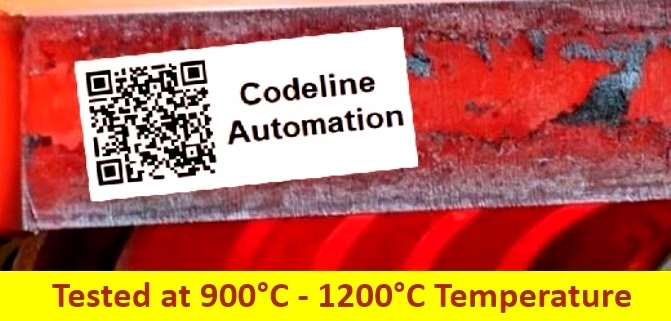Heat Resistant Labels

Specifically, our labels can withstand temperatures between 250 °C and 1250 °C, making them perfect for the steel and manufacturing industries where it is critical to effectively monitor samples or batches exposed to harsh conditions.
Heat Resistant Labels and Tags
If you work in an industry that requires high-temperature labels, you understand the importance of having a dependable product.
Using an alternative label material that is not designed for the demands of your
environment may cause the label to fade or become illegible if they are exposed to excessive heat. Conversely, high-temperature labels and tags are ideal for these applications, as they won’t melt or become distorted at high temperatures.
We can supply high-temperature labels and tags in different colours and finishes. For example, they can be branded with your company logo. More specific text can be overprinted with variable information, such as serial numbers, batch codes, or barcodes.
Some common uses include tracking metal products, labelling food items in ovens, products undergoing autoclave processes, ceramics, and sanitary ware. To sum it up, choosing the right high-temperature label ensures safety and compliance in your workplace, without sacrificing the legibility of crucial information.
Heat Resistant Labels
We understand that the required temperature resistance depends on the industry, with some clients’ labels needing to withstand temperatures up to 1250 °C, while others only need to be resistant to 250 °C. Whatever you need, it’s crucial to choose the right label for the job.
Given the range of requirements, it is essential to understand that each label type has its own unique set of attributes and applications. Some labels are designed to withstand high temperatures for extended periods of time, whereas others are only suitable for brief intervals.
Specifying the right label can contribute to safety and compliance in your workplace by preventing key information from melting or disappearing. Subsequently, you can ensure the label remains clear and legible throughout the product’s life.
Additionally, it is crucial to keep in mind that some labels can be applied in high-temperature environments, while others can only be applied at ambient temperature. Furthermore, certain labels require specialized equipment for proper application.
How much would I pay for Heat Resistant Labels
As heat-resistant labels are a specialized product, the cost varies according to the label size,
volume and the heat resistant labels requirements. With our extensive experience in the design of labels and tags, you can rest assured that we can assist you in optimizing your label design.
We aim to minimize any unused space and help you reduce the cost of your heat resistant labels and tags. Fortunately, with our expertise, you can enjoy the peace of mind that comes with having high-quality, cost-effective labelling solutions.
Heat Resistant Labels Products
| Treated Polyester Labels | Up to 250 °C | Use standard thermal transfer printer with matched resin ribbon. Applied by hand. Multiple colours and wide range of sizes. Suitable for different temperature ranges. |
| Polyimide Adhesive Labels | Up to 350 °C | Use standard thermal transfer printer with matched resin grade ribbon. Applied by hand and suitable for exposure up to 350 °C for short periods. |
| Aluminum Foil Base Adhesive with Inorganic Topcoat | Up to 600 °C | Aluminium base material with a smudge-proof coating and with a silicone adhesive. Thermal transfer topcoat can be printed onto using a specialist thermal transfer ribbon. Apply by hand or using specialist tool at temperatures between room temperature and 450 °C. Can withstand short-term exposure up to 600 °C. |
| Ceramic-coated Polymer Film Adhesive Labels | Up to 1250 °C | Designed to be stuck to high-temp metal, ceramic and glass. Thermal transfer printed with specialist high grade resin-based ribbon. Resistant to chemicals, heat, shock and scratching. Apply by hand at low temperatures or using a special tool at temperatures up to 1250 °C. |

